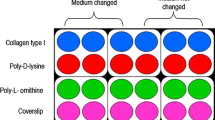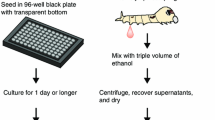Summary
A highly nutritive culture medium (MGM-464) was developed for insect cell primary culture. The new medium consists of 6 inorganic salts, 4 organic acids, 21 amino acids, 3 sugars, 10 vitamins, and 8 other chemicals, including natural substances. The complete medium was generated by adding 20 ml fetal bovine serum to 100 ml MGM-464. The detail of the composition of the medium is given in a table, and the protocol to prepare the medium is described in the text. Among the 15 kinds of cultures made with MGM-464, embryonic cells from a walking stick and ovarian cells from the common white were subcultured more than 70 times, and embryonic cells of a chrysomelid beetle were subcultured more than 15 times. Other cultures could not be subcultured. However, embryonic cells from the commercial silkworm and a cockroach, ovarial cells from the commercial silkworm and a sphingid moth, nervous cells from the commercial silkworm and two sphingid moths, and cells from the dorsal vessel plus surrounding tissue of the commercial silkworm survived for several mo. The cells from the honeybee embryos, aphid embryos, and planthopper embryos were rather short-lived, and deteriorated after about 1 mo.
Similar content being viewed by others
References
Carlson, J. G. Protoplasmic viscosity changes in different regions of the grasshopper neuroblast during mitosis. Biol. Bull. 90:109–121; 1946.
Crawford, A. M. A coleopteran cell line derived fromHeteronychus arator (Coleoptera; Scarabaeidae). In Vitro 18:813–816; 1982.
Giauffret, A.; Quiot, J.-M.; Vago, C.; Poutiers, F. Cultures cellulaire d'Apis mellifera. In: Barigozzi, C., ed. Proceeding of the 2nd International Colloquium on Invertebrate Tissue Culture. Instituto Lombardo; 1968:74–80.
Gillot, C. Entomology. 2nd Ed. New York: Plenum Press; 1995:798pp.
Grace, T. D. C. Establishment of four strains of cells from insect tissues grown in vitro Nature 195:788–789; 1962.
Grace, T. D. C. Establishment of a line of cells from the silkwormBombyx mori. Nature 216:6103; 1967.
Gullan, P. J.; Cranston P. S. The insects: an outline of entomology. London: Chapman and Hall; 1994:491pp.
Inoue, H.; Mitsuhashi, J. ABombyx mori cell line susceptible to a nuclear polyhedrosis virus. J. Seric. Sci. Jpn. 53:108–113; 1984.
Iwabuchi, K. Early embryonic development of a polyembryonic wasp,Litomastix maculata Ishii, in vivo and in vitro. Appl. Entomol. Zool. 26:563–570; 1991.
Landureau, J. C. Cultures in vitro de cellules embryonnaires de blattes (insectes, dictyoptère). II. Obtention de lignées cellulaires à multiplication continué. Exp. Cell Res. 50:323–337; 1968.
Lynn, D. E. A new insect cell line from the Colorado potato beetle. In Vitro Cell. Dev. Biol. 31:91–93; 1995.
Lynn, D. E. Novel techniques to establish new insect cell lines. 10th International Conference on Invertebrate Cell and Tissue Culture, San Diego, CA, 2000 [Abstract 12A; 2000].
Lynn, D. E.; Stoppleworth, A. Established cell lines from the beetle,Diabrotica undecimpunctata (Coleoptera: Chrysomelidae). In Vitro 20:365–368; 1984.
Mitsuhashi, J. Preliminary report on the primary culture of smaller brown planthopper cell in vitro. Appl. Entomol. Zool. 4:151–153; 1969.
Mitsuhashi, J. A continuous cell line from a beetle,Anomala costata Hope (Coleoptera, Scarabaeidae). J. Jpn. For. Soc. 71:491–496; 1989.
Mitsuhashi, J. A continuous cell line from pupal ovaries of the common cutworm,Spodoptera litura (Lepidoptera: Noctuidae). Appl. Entomol. Zool. 30:75–82; 1995.
Mitsuhashi, J. A continuously growing cell line from larval hemocytes ofMalacosoma neustria testacea. Jpn. J. Entomol. 64:692–699; 1996.
Mitsuhashi, J.; Inoue, H. Obtainment of a continuous cell line from the larval fat bodies of the mulberry tiger moth,Spilosoma imparilis (Lepidoptera: Arctiidae). Appl. Entomol. Zool. 23:488–490; 1988.
Mitsuhashi, J.; Oshiki, T. Preliminary attempts to rear and endoparasitic fly,Exorista sorbillans (Diptera, Tachinidae) in vitro. Jpn. J. Entomol. 61:459–464; 1993.
Ohbayashi, T.; Iwabuchi, K.; Mitsuhashi, J. In vitro rearing of a larval endoparasitoid,Venturia canescens (Gravenhorst) (Hymenoptera, Ichneumonidae). I. Embryonic development. Appl. Entomol. Zool. 29:123–126; 1994.
Peters, D.; Black, L. M. Techniques for the cultivation of cells of the aphidAcyrthosiphon pisum in primary cultures. Tag. Ber. Dt. Adad. Landwirtsch.-Wiss. Berlin. Nr. 115:129–139; 1971.
Tapay, L. M.; Lu, Y.; Brock, J. A.; Nadala Jr., E. C. B.; Loh, P. C. Transformation of primary cultures of shrimp (Penaeus stylirostris) lymphoid (Oka) organ with Simian Virus-40 (T) antigen. Proc. Soc. Exp. Biol. Med. 209:734–778; 1995.
Tokumitsu, T.; Maramorosch, K. Survival of aphid cells in vitro. Exp. Cell Res. 44:652–655; 1966.
Yamada, K.; Tokumitsu, T.; Shikata, E. Embryonic tissue culture ofLaodelphax striatellus Fallén. Jpn. J. Appl. Entomol. Zool. 14:79–84; 1970. [in Japanese with English summary].
Author information
Authors and Affiliations
Corresponding author
Rights and permissions
About this article
Cite this article
Mitsuhashi, J. Development of highly nutritive culture media. In Vitro Cell.Dev.Biol.-Animal 37, 330–337 (2001). https://doi.org/10.1007/BF02577566
Issue Date:
DOI: https://doi.org/10.1007/BF02577566




